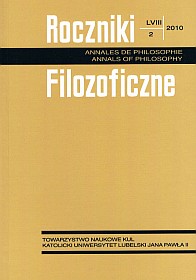Simplicity of the Cosmological Model vs. Complexity of the Universe
Abstract
In this paper we continue our previous investigation od Akaike simplicity criterion [16] which plays the crucial role in the E. Sober philosophy of science [29] in the context of the modern cosmology.
We consider different models of accelerating Universe which describe the current evolution of the Universe. We demonstrate that the generalized Akaike criterion (Bozdogen criterion) distinguishes the very simple standard cosmological model called LCDM (Lamda Cold Dark Matter model) whereas the standard Akaike criterion doesn’t give such unique indication. We demonstrate that the case study of cosmological models may be suitable in searching for more adequate criterion of the simplicity in the context of the philosophy of science.
References
Bailer-Jones D.M., When scientific models represent, „International Studies in the Philosophy of Science” 17 (2003), no. 1, s. 59-74.
Bridle S.L., Lahav O., Ostriker J.P., Steinhardt P.J., Precision cosmology? not just yet, „Science” 299 (2003), s. 1532.
Eddington A.S., Czy wszechświat sie rozszerza?, Warszawa: WUW 2006.
Efstathiou G., Limitations of Bayesian Evidence Applied to Cosmology, „Monthly Notices of the Royal Astronomical Society” 388 3 (2008), s. 1314-1320.
Ellis G., Buchert T., The universe seen at different scales, „Physics Letters A” 347 (2005), s. 38-46.
Feyerabend P.K., Explanation, reduction, and empiricism, [w:] Minnesota Studies in the Philosophy of Science, ed. H. Feigl, G. Maxwell, Minneapolis: University of Minnesota Press 1962, s. 28-97.
Giere R.N., How models are used to represent reality, „Philosophy of Science” 71 12 (2004), s. 742-752.
Gingerich O., How Galileo changed the rules of science, „Sky and Telescope” 85 (1993), s. 32-36.
Grobler A., Metodologia nauk, Kraków: Aureus i ZNAK 2006.
Hajduk Z., Pojęcie i funkcja modelu, „Roczniki Filozoficzne” 20 (1972), z. 3, s. 77-124.
Hartmann S. , Modeling in philosophy of science, [w:] M. Frauchiger, W.K. Essler (eds.), Representation, Evidence, and Justification: Themes from Suppes, (Lauener Library of Analytical Philosophy, vol. 1), Frankfurt: ontos Verlag 2008.
Hrycyna O., Szydłowski M., Route to lambda in conformally coupled phantom, „Physics Letters B” 651 (2007), s. 8.
Hrycyna O., Szydłowski M., Extended Quintessence with non-minimally coupled phantom cosmology, „Physical Review D” 76 (2007), s. 123510.
Kashyap R., Inconsistency of the AIC rule for estimating the order of autoregressive models, „IEEE Trans. Auto. Control” 25 (1980), s. 996-998.
Kowalski M. [et al.], Improved cosmological constraints from new, old and combined supernova datasets, „The Astrophysical Journal” 686 749 (2008).
Kukier Ł., Szydłowski M., Tambor P., Kryterium Akaike: prostota w jezyku statystyki, „Roczniki Filozoficzne” 57 (2009), nr 1, s. 97-126.
Kurek A., Hrycyna O., Szydłowski M., Constraints on oscillating dark energy models, „Physics Letters B” 659 (2008), s. 14.
Kurek A., Kukier Ł., Szydłowski M., Tambor P., Wstęp do bayesowskiej metodologii współczesnej kosmologii, „Zagadnienia Filozoficzne w Nauce” 45 (2009), s. 62-96.
Kurek A., Szydłowski M., The ΛCDM Model in the Lead-A Bayesian Cosmological Model Comparison, „The Astrophysical Journal” 675 (2008), s. 1-7.
Lemaître G., The expanding universe, „Monthly Notices of the Royal Astronomical Society” 91 (1931), s. 490-500.
Liddle A.R., How many cosmological parameters?, „Monthly Notices of the Royal Astronomical Society” 351 (2004), s. L49-L53.
Liddle A.R., Information criteria for astrophysical model selection, „Monthly Notices of the Royal Astronomical Society” 377 (2007), s. L74-L78.
Lukash V., Cosmological model: from initial conditions to structure formation, „Nuovo Cimento” B122 (2007), s. 1411-1422.
Morrison M., Modeling nature: Beetwen physics and the physical world, „Philosophia Naturalis” 54 (1998), s. 65-85.
Morrison M., Approximating the real: The role of idealizations in physical theory, [w:] Idealization xii: Correcting the model, idealization and abstraction in the sciences, „Poznan Studies in the Philosophy of the Sciences and the Humanities” 86 (2006), s. 145-172.
Mrożek J., Status poznawczy matematyki, Gdańsk: Wydawnictwo Uniwersytetu Gdańskiego 2004.
Nagel E., Struktura nauki, Warszawa: PWN 1961.
Smith S.R., Models and the Unity of the Classical Physics: Nancy Cartwright’s Dappled World, „Philosophy of Science” 68 12 (2001), s. 456-475.
Sober E., Instrumentalism, parsimony, and the akaike framework, „Philosophy of Science” 69 (2002), s. 112-123.
Sober E., What is the problem of simplicity?, [w:] H. Keuzenkamp, M. McAleer, A. Zellner (eds.), Simplicity, Inference, and Econometric Modelling, Cambridge University Press, Cambridge 2002, s. 13-32.
Sokołowski L.M., Teorie efektywne i emergencja fizycznego obrazu świata, [w:] M. Heller, J. Mączka (eds.), Struktura i Emergencja, Tarnów: Biblos 2006.
Staruszkiewicz A., Co znaczą słowa Einsteina „Bóg pomysłowy, lecz nie złośliwy”, „Roczniki Filozoficzne” 28 (1980), s. 67-69.
Suppe F., The Semantic Conception of Theories and Scientific Realism, Chicago 1989.
Suppes P., Set-Theoretical Structures in Science, Stanford 1967.
Szydlowski M., Cosmological zoo: Accelerating models with dark energy, „Journal of Cosmology and Astroparticle Physics” 0709 (2007), s. 007.
Szydłowski M., Kurek A., AIC, BIC, Bayesian evidence and a notion on simplicity of cosmological model, (2008), e-print: arXiv:0801.0638.
Szydłowski M., Kurek A., Krawiec A., Top ten accelerating cosmological models, „Physics Letters B” 642 (2006), s. 171-178.
Szydłowski M., Tambor P., Model Kosmologiczny (LCDM,CDM) w schemacie pojęciowym efektywnych teorii wszechświata, „Filozofia Nauki” 19 (2008), s. 119-139.
Trotta R., Bayes in the sky: Bayesian inference and model selection in cosmology, „Contemporary Physics” 49 (2008), no. 2, s. 71-104.
Trotta R., Bayes in the sky: Bayesian inference and model selection in cosmology, „Contemporary Physics” 49, 2 (2008), s. 71-104.
van Fraasen B., Laws and Symmetry, Oxford: Clarendon Press 1989.
Weinberg S., Gravitation and Cosmology, New York: Wiley 1972.
Wigner E., The unreasonable effectiveness of mathematics in the natural sciences, „Communications in Pure and Applied Mathematics” 13 (1960), no. 1.
Copyright (c) 2010 Roczniki Filozoficzne

This work is licensed under a Creative Commons Attribution-NonCommercial-NoDerivatives 4.0 International License.





